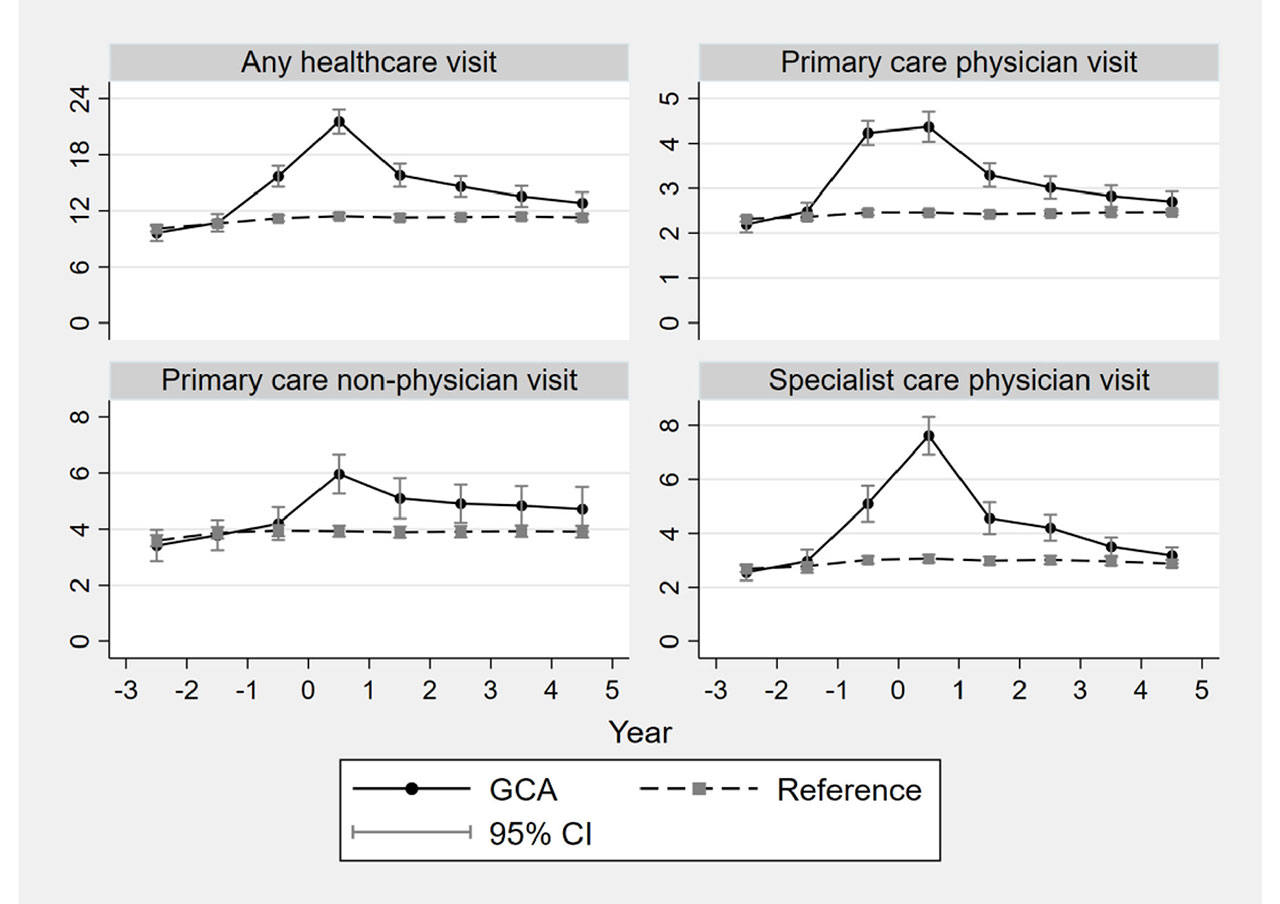Session Information
Date: Tuesday, November 12, 2019
Title: Vasculitis – Non-ANCA-Associated & Related Disorders Poster III: Giant Cell Arteritis
Session Type: Poster Session (Tuesday)
Session Time: 9:00AM-11:00AM
Background/Purpose: To study the healthcare resource utilization (HRU) in patients with giant cell arteritis (GCA) compared with the background population in southern Sweden.
Methods: The study includes patients diagnosed with biopsy-proven GCA between 2001 and 2011 and their randomly selected age-, sex- and residency area matched reference persons (1:10). Data on all healthcare consultations and admissions were extracted from a regional administrative database, the Skåne Healthcare Register, which records data on all healthcare consultations and hospitalizations using the ICD-10 codes. Frequencies of HRU were analysed as numbers and rates of primary healthcare visits, hospital visits and hospitalizations. HRU was assessed from three years prior to index date (i.e. the date of GCA diagnosis for both GCA and their respective matched reference subjects) to five years after. The HRU (i.e. the number of healthcare visits) during 5 years after the index date was analysed using zero-inflated negative binomial regressions assuming the same propensity to use healthcare for both GCA and references and adjusted for sex, age, year of diagnosis, and HRU over 3-year before index date.
Results: The matched cohort included a total of 7,282 subjects (GCA patients, n = 662; references,
n =6,620) with mean (SD) age 75.3 (8.3) years, and 73.4% women. Over 5 years after index date, HRU was higher in patients with GCA compared to reference subjects with incidence rate ratios of 1.36 (95% CI 1.29-1.44) for all visits, 1.21 (1.14-1.28) for primary healthcare physician visits and 1.47 (1.39-1.56) for specialist care physician visits (Table 1). Hospital admissions were more frequent among GCA patients with rate ratios of 1.23 (1.11-1.36) for admissions and 1.41 (1.24-1.60) for inpatient days. Notably, the HRU started to diverge from the year before the index date up to four years after (Figure 1). When stratifying consultations or hospitalization by diagnoses, consultations rates were higher in GCA patients than in reference subjects for the following diagnoses: infections, cardiovascular diseases, respiratory diseases, musculoskeletal, nervous disorders and ear and eye diseases. However, endocrine diagnoses were lower prior to the onset of GCA compared to the period preceding the index date in reference subjects.
Conclusion: In this population-based study, patients with GCA had higher rates of HRU compared to the reference population. The increase in HRU was evident one year before diagnosis and continued over four years after. The systemic inflammatory burden and the adverse effects of treatment may account for the increase in the HRU after GCA diagnosis.
To cite this abstract in AMA style:
Mohammad A, Turkiewicz A, Stamatis P, Turesson C, Englund M, Kiadaliri A. Healthcare Resources Utilization in Giant Cell Arteritis – a Population-Based Study [abstract]. Arthritis Rheumatol. 2019; 71 (suppl 10). https://acrabstracts.org/abstract/healthcare-resources-utilization-in-giant-cell-arteritis-a-population-based-study/. Accessed .« Back to 2019 ACR/ARP Annual Meeting
ACR Meeting Abstracts - https://acrabstracts.org/abstract/healthcare-resources-utilization-in-giant-cell-arteritis-a-population-based-study/


